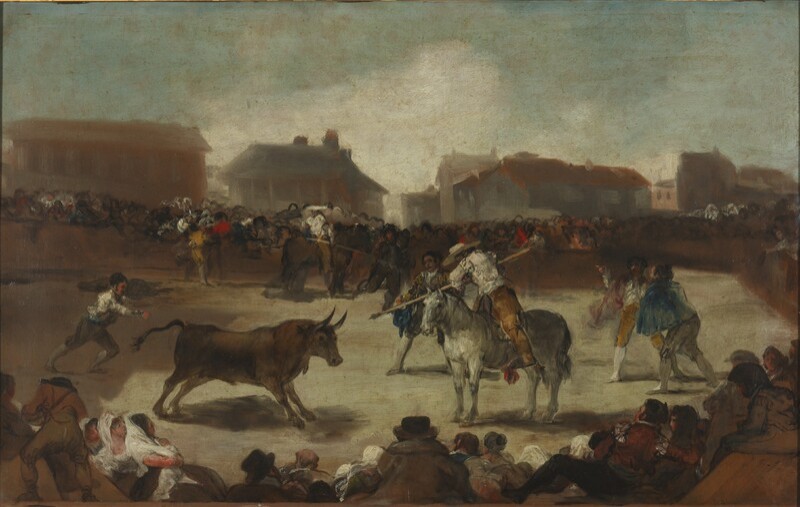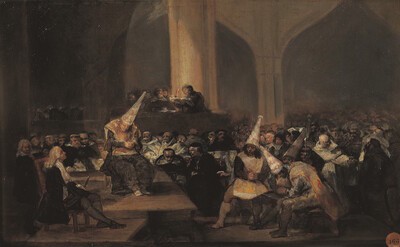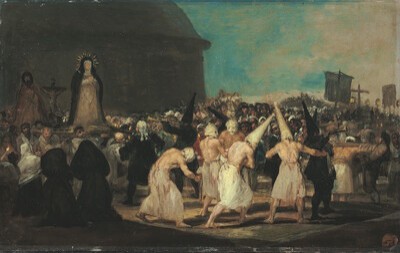- Cronología
- Ca. 1814 - 1816
- Ubicación
- Royal Academy of Fine Arts of San Fernando. Madrid, Madrid, Spain
- Dimensiones
- 45 x 72 cm
- Técnica y soporte
- Oil on wood panel
- Reconocimiento de la autoría de Goya
- Documented work
- Titular
- Royal Academy of Fine Arts of San Fernando
- Ficha: realización/revisión
- 26 Apr 2010 / 15 Jun 2023
- Inventario
- (675)
See The Madhouse.
For a history of the whole series, see The Madhouse.
This scene of a popular festival, ostensibly a simple genre painting for decorative purposes, is actually another representation of the madness which appears to be the leitmotiv of this set of works. Goya was a great fan of bullfighting, as demonstrated by the numerous works of varying techniques with a bullfighting theme which he produced throughout his artistic career. Nevertheless, the excesses which characterized this kind of festival, attended by spectators of all classes, were also well known to him. In fact, from the time of Philip V onwards, various royal decrees motivated by enlightened thinking were passed which banned the killing of the bull, or even the spectacle itself. But official vetoes were ignored, and all kinds of people - clerics, youths, old people, young fashionable women - continued to attend this spectacle held all over Spain and New Spain in their droves. Audiences crowded around a bullring improvised with wooden boards in a plaza.
This is exactly what Goya has represented here. There is a row of houses in the background which suggests that the setting for this bullfight is a town, carried out in light, thin brushstrokes in greyish tones which blend in with the sky. The wooden ring which separates the spectators from the fight is perfectly visible, although the furthest away part from the viewer becomes a vague, ill-defined stain, like the houses and the figures in that part of the composition. Looking along the fence we can make out figures enjoying the bullfight arranged on both sides of a man who is sitting with his back to us, forming the central axis of the scene. In the middle of the ring, a picador (mounted bullfighter) gets ready to prick the bold bull, who is tense and alert. There are some bullfighters and, in the background, another picador.
Behind the seated figure in the right-hand corner whose body allows the reddish ground of the panel to show through, there is a woman looking at the viewer with wide-open eyes. Her face reflects the horror of the spectacle she witnesses, the only one aware of the brutality of the bullfight and the madness of the masses.
-
Goya 1900Ministerio de Instrucción Pública and Bellas ArtesMadrid1900consultant editors Aureliano de Beruete, Alejandro Ferrant, Marqués de Pidal and Ricardo Velázquez. May 1900cat. 14
-
Goya: toros y torerosEspace Van GoghArles1990displayed also at Academia de Bellas Artes de San Fernando, Madrid, consultant editor Pierre Gassier.cat. 13
-
Goya. El Capricho y la Invención. Cuadros de gabinete, bocetos y miniaturasMuseo Nacional del PradoMadrid1993from November 18th 1993 to February 15th 1994. Exhibited also at the Royal Academy of Arts, London, March 18th to June 12th 1994 and The Art Institute of Chicago, Chicago, July 16th to October 16th 1994, consultant editors Manuela B. Mena Marqués and Juliet Wilson-Bareaucat. 95
-
Realidad e imagen. Goya 1746 – 1828Museo de ZaragozaZaragoza1996consultant editor Federico Torralba Soriano. From October 3th to December 1st 1996cat. 119
-
Goya: Prophet der ModerneAlte NationalgalerieBerlin2005from July 13th to October 3th 2005. Exhibitied also at the Kunsthistorischemuseum, Vienna, October 18th 2005 to January 8th 2006, consultant editor Manuela B. Mena Marquéscat. 57
-
Goya en tiempos de guerraMuseo Nacional del PradoMadrid2008consultant editor Manuela B. Mena Marqués, from April 14th to July 13th 2008cat. 128
-
GoyaBasle2021p. 296
-
L'œuvre peint de Goya. 4 volsParís1928-1950vol. I, p. 272, cat. 247
-
Vie et ouvre de Francisco de GoyaParísOffice du livre1970pp. 256, 266, cat. 969
-
BarcelonaPolígrafa1970vol. I, p. 319, cat. 465
-
L’opera pittorica completa di GoyaMilanRizzoli1974p. 127, cat. 559
-
Francisco de Goya, 4 vols.ZaragozaCaja de Ahorros de Zaragoza, Aragón y Rioja1980-1982vol. III, p. 175 y vol. IV, p. 247 (il.)
-
Goya, toros y torerosMadridMinisterio de Cultura, Comunidad de Madrid1990pp. 74-75
-
Goya. El capricho y la invención. Cuadros de gabinete, bocetos y miniaturasMadridMuseo del Prado1993pp. 314-320, 378-379, cat. 95 y p. 315 (
-
Goya en tiempos de guerraMadridMuseo Nacional del Prado2008pp. 379-380, 382-384, cat. 128 y p. 383



